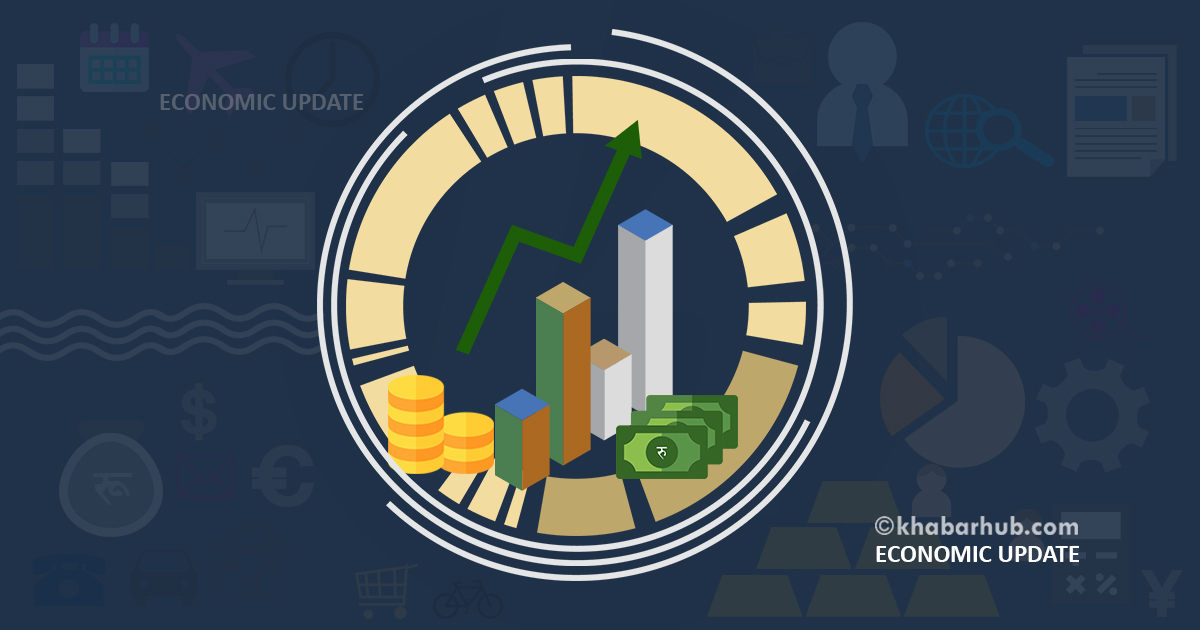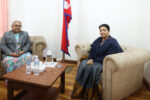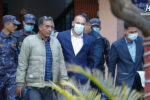KATHMANDU: Economic Digest offers a concise yet comprehensive overview of significant business happenings in Nepal, presented in easily digestible summaries.
Recent developments in Nepal’s economy highlight significant trends across various sectors.
Gold prices surged by Rs 54,000 per tola, reaching a record high of Rs 161,300, driven largely by international market dynamics, geopolitical tensions, and increased demand for safe-haven assets last week.
This trend reflects a complex relationship between global economic conditions and local market behaviors.
Meanwhile, tourist arrivals in the Annapurna Conservation Area have risen sharply, with 34,651 foreign visitors over the past three months, underscoring the region’s growing popularity for trekking and its potential for boosting local economies.
In agricultural markets, the Food Management and Trading Company is set to sell goats at reduced prices for the Dashain festival, aimed at making livestock more affordable for consumers.
On the financial front, the Nepal Stock Exchange rebounded with a gain of 110.73 points, reflecting renewed investor confidence and resulting in Rs 176.2 billion in capital gains.
Meanwhile, Nepal is set to receive Rs 1.06 billion from carbon trading, a testament to its effective forest conservation efforts, with a significant portion of the revenue earmarked for local communities.
Collectively, these trends indicate a period of recovery and potential growth for Nepal’s economy amid external challenges.
Surging gold prices reflect international trends
The recent rise in gold prices in the domestic market, which has increased by Rs 54,000 per tola to reach a record high of Rs 161,300, illustrates the complex interplay of global and local market dynamics.
This surge is largely attributed to rising international gold prices, driven by a variety of factors that have heightened demand and influenced investor behavior.
Geopolitical conflicts play a significant role in shaping gold prices. As tensions between countries escalate, investors often turn to gold as a safe-haven asset, seeking to protect their wealth from economic instability.
This increased demand creates upward pressure on prices. Furthermore, the global appetite for gold remains strong, particularly as central banks and individual investors look to build their reserves, intensifying competition for this precious metal.
Economic fluctuations, especially in the United States, also impact gold prices. Factors such as interest rate changes and inflation concerns can make gold more appealing as an investment, especially when the dollar weakens.
In an environment of low interest rates, gold often becomes more attractive, leading to increased buying activity that further drives prices up.
Compounding these influences are the recent changes in Nepal’s import duties on precious metals.
The government’s decision to raise these duties has likely constrained supply, leading to higher local prices.
Importers facing increased costs typically pass these on to consumers, further elevating retail prices.
Interestingly, the gold market in Nepal exhibited a period of stability from October to February, where prices hovered around Rs 120,000 per tola.
This stability suggests a temporary equilibrium, likely resulting from a balance between supply and demand during that timeframe.
However, starting in March 2024, prices began to climb again, reflecting a shift in market conditions and the impact of external pressures.
In the last six months alone, gold prices have surged by Rs 35,500, moving from Rs 125,800 to Rs 161,300.
By mid-August, the price stood at Rs 152,600, indicating a persistent demand for gold despite the fluctuations.
This trend suggests that investors increasingly regard gold as a reliable store of value amid ongoing economic uncertainties.
The rise in gold and silver prices in Nepal highlights the intricate relationship between local market conditions and broader global factors.
Tourist arrivals in Annapurna Conservation Area surge
Tourist arrivals in the Annapurna Conservation Area, renowned for its trekking opportunities, have seen a notable increase.
Over the past three months, a total of 34,651 foreign tourists have visited the region.
Data from the Annapurna Conservation Area Project (ACAP) indicates that September alone welcomed 23,088 tourists, a significant jump from the 5,249 visitors recorded in July. In August, the number of foreign tourists reached 6,314.
Dr. Rabin Kadariya, head of the project, noted that September and October are the peak months for tourist visits this year.
Among the September arrivals, 11,682 were from South Asian countries, while 11,406 came from other regions.
In August, the breakdown included 3,383 tourists from the SAARC region and 2,931 from elsewhere, and in July, 3,350 SAARC visitors and 1,893 from other countries entered the area.
The Annapurna region offers various attractions, with popular destinations including Annapurna Base Camp, Mardi Himal, Ghandruk, Sikles, Khumaidanda, Tilicho Lake in Manang, Thorangbhanjyang, Upper Mustang, Muktinath, and Ghodepani in Myagdi.
Last fiscal year, the area hosted 222,180 foreign tourists, with 117,845 hailing from Asian countries and approximately 100,000 from other parts of the world.
This trend reflects a growing interest in the region’s natural beauty and trekking potential.
FMTC to offer goats at affordable prices
The Food Management and Trading Company Limited (FMTC) is set to sell goats and mountain goats at reduced prices for the upcoming Dashain festival in the Kathmandu Valley, starting Sunday.
According to FMTC spokesperson Sharmila Subedi Neupane, 208 goats had already arrived in the capital by Saturday, with plans for the remaining 1,500 goats and 300 mountain goats to arrive soon, contingent on road conditions.
The pricing has been established at Rs 670 per kg for regular goats and Rs 1,230 per kg for mountain goats, reflecting a Rs 10 discount compared to last year.
The FMTC noted that these lower prices are due to more favorable procurement rates this year.
In contrast, last year’s prices were Rs 680 per kg for goats and Rs 1,260 per kg for mountain goats.
Historically, around 50,000 goats are sold in the Kathmandu Valley during Dashain, making this a significant market event.
This year’s price adjustments may encourage more buyers, indicating the FMTC’s efforts to enhance affordability for consumers.
NEPSE rallies with 110.73-point gain
The Nepal Stock Exchange (NEPSE) experienced a significant recovery last week, gaining 110.73 points after a prolonged bearish trend lasting over a month.
Opening the week at 2,486.76 points, the index closed at 2,597.49 points by Wednesday, showcasing notable volatility with highs of 2,643.76 points and lows of 2,442.61 points.
Despite a negative start on Sunday, where the index dropped by 22.36 points, it rebounded with gains of 44.45 points and 114.70 points on Monday and Tuesday, respectively.
Wednesday saw a slight decline of 26.07 points as trading concluded for the week, coinciding with the government’s public holiday for Ghatasthapana, marking the start of the Dashain festival.
Among the market sectors, only the mutual fund group registered a loss, slipping by 0.13 points.
Conversely, the life insurance sector led gains with an impressive increase of 637.34 points.
The finance index also experienced a significant rise, jumping by 14.13 percent.
Overall, eight groups saw their indices climb by triple-digit points, reflecting renewed investor confidence and contributing to a total capital gain of Rs 176.2 billion during the week.
This rebound suggests a positive shift in market sentiment as investors respond favorably to improved economic conditions.
Nepal set to receive Rs 1.06 billion from carbon trade for emission reductions
Nepal is poised to receive Rs 1.06 billion as compensation for reducing carbon dioxide emissions through its forest conservation efforts in 13 Terai districts.
This funding, facilitated by the REDD Implementation Center under the Ministry of Forest and Environment, is a result of Nepal’s successful carbon storage initiatives, which have sequestered approximately 2.4 million tons of carbon between 2018 and 2024.
The payment structure is based on a rate of $5 per ton of carbon dioxide emissions reduced, with the total amount expected to be disbursed this October.
The initiative aligns with the Terai Arc Landscape program, which spans from the Bagmati River to the Mahakali River, highlighting Nepal’s commitment to environmental sustainability and climate change mitigation.
Significantly, 80 percent of the revenue generated from carbon trading is mandated to be allocated to indigenous and local communities, ensuring that the benefits of this initiative reach those most affected by environmental changes.
Badriraj Dhungana, spokesperson and joint secretary at the Ministry of Forest and Environment, emphasized that a detailed plan has been developed for the equitable distribution of these funds.
This financial influx not only underscores Nepal’s efforts in carbon management but also presents an opportunity to bolster local economies and empower communities engaged in conservation practices.
Overall, this initiative represents a positive step towards sustainable development and climate resilience in Nepal.
(Prepared by Srija Khanal)









Comment